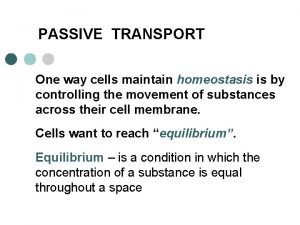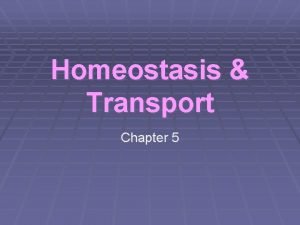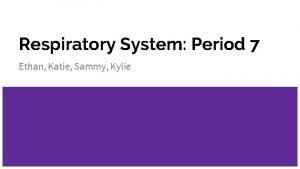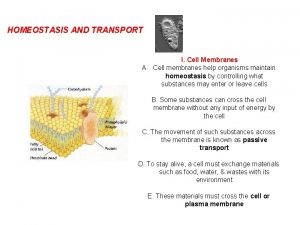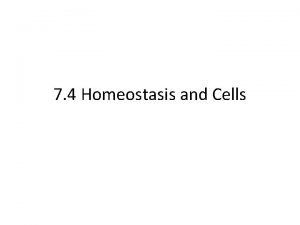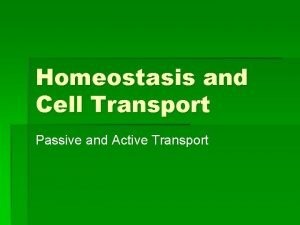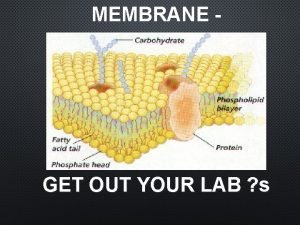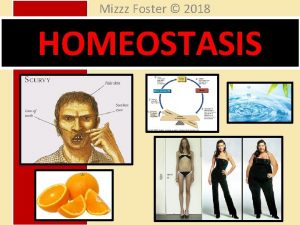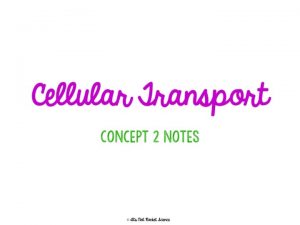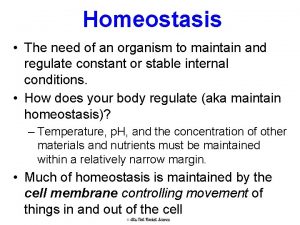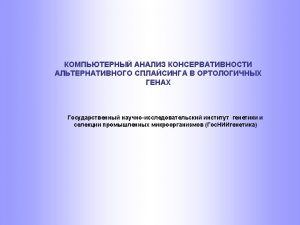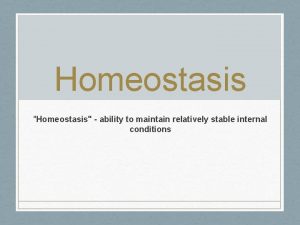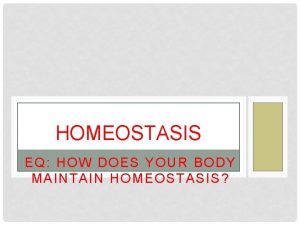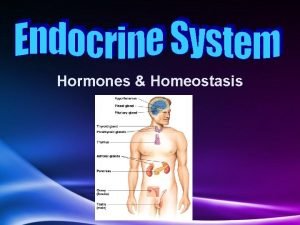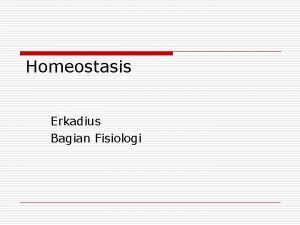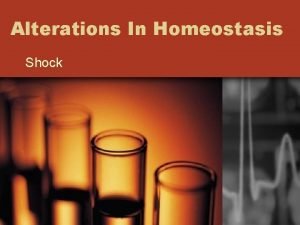Homeostasis The need of an organism to maintain
















- Slides: 16


Homeostasis • The need of an organism to maintain and regulate constant or stable internal conditions. • How does your body regulate (aka maintain homeostasis)? – Temperature, p. H, and the concentration of other materials and nutrients must be maintained within a relatively narrow margin. • Much of homeostasis is maintained by the cell membrane controlling movement of things in and out of the cell

Cell Membrane • The cell membrane is said to be selectively permeable, meaning certain substances can move across it freely, while others must move through a “gate”. • Transport of materials can be classified as either passive transport or active transport.

Cellular Transport • Passive Transport requires no extra energy by the cell because molecules move from high concentration (squished together) to low concentration (spread out) areas down the concentration gradient. • Active Transport requires extra energy (ATP) to be spent to bring materials into the cell or expel materials out of the cell moving from low concentration to high concentration against the concentration gradient.

Examples of Transport • Passive Transport – Diffusion – Osmosis – Facilitated Diffusion • Active Transport – Molecular Pumps – Exocytosis – Endocytosis

Words to Know • Solute – what gets dissolved (Ex. Lemonade powder) • Solvent – does the dissolving (Ex. Water) • Solution – uniform mixture of two or more substances (Ex. Lemonade) • Concentration – amount of solute dissolved in solvent • Symbol for abbreviation = [ ]

Passive Transport: Diffusion • The spreading out of molecules across a membrane until they are equally concentrated on both sides of the membrane. • Molecules move down a concentration gradient, from high [ ] to an area of low [ ] – Ex. Oxygen and Carbon Dioxide Over time…

Passive Transport: Facilitated Diffusion • A transport protein acts as a protein channel to help (facilitate) the diffusion of molecules that normally couldn‘t pass through the cell membrane • Molecules move down a concentration gradient, from high [ ] to an area of low [ ] – Ex. Glucose/sugar, sodium/salt Over time…

Passive Transport: Osmosis • The diffusion of water across the cell membrane • Water molecules move down a concentration gradient, from high [ ] to an area of low [ ] Over time…

Passive Transport: Osmosis • Hypertonic solutions: water concentration is below what is found in a cell’s cytoplasm. – Water will tend to move out of the cell, down its concentration gradient Cell shrivels • Hypotonic solutions: water concentration is above what is found in a cell’s cytoplasm. – Water will tend to move into a cell, down its concentration gradient Cell swells • Isotonic solutions: identical water concentrations to what is found in a cell’s cytoplasm Cell stays the same

Passive Transport: Osmosis Hypertonic H 2 O H 2 O Cell shrivels Hypotonic Isotonic H 2 O H 2 O Cell swells H 2 O Cell stays the same

Active Transport • Remember – not all substances can move so freely into a cell. • Some molecules have to be pushed “uphill, ” against a concentration gradient. – This means substances are moving from an area of low [ ] to an area of high [ ] • Other substances are too big to move through a protein channel, and have to be enveloped by the cell or excreted by the cell. – This is accomplished by either endocytosis or exocytosis.

Active Transport: Molecular Pumps • When a cell uses energy to pump molecules across the membrane through a protein channel. • This allows a cell to concentrate key molecules within the cell, or remove waste quickly from the cell. – Ex. Calcium (Ca 2+), potassium (K+), chlorine (Cl-) and sodium (Na+) = ions (charged particles) ENERGY Over time…

Active Transport: Endocytosis • A cell uses energy to import large amounts of materials INTO the cell using a vesicle • Ex. White blood cells engulf bacteria to fight infection

Active Transport: Exocytosis • A cell uses energy to export large amounts of materials OUT OF the cell using a vesicle • Ex. Nerve cells release neurotransmitters to pass signals to the brain

Practice Time! Type of Transport Passive/Acti ve Ex. of what is being moved Facilitated Diffusion How it helps maintain homeostasis Regulates blood sugar Active Endocytosis Neurotransmitters Captures bacteria Passive Controls blood pressure by regulating blood volume O 2 and CO 2 K+, Na+, Ca 2+, Cl- Muscle contractions and nerve signal conduction
 Prosmosis
Prosmosis How do cells maintain homeostasis
How do cells maintain homeostasis Kylie knh
Kylie knh How do cells maintain homeostasis
How do cells maintain homeostasis What do unicellular organisms do to maintain homeostasis
What do unicellular organisms do to maintain homeostasis What is homeostasis
What is homeostasis Bioflix activity homeostasis low blood glucose
Bioflix activity homeostasis low blood glucose Bioflix activity homeostasis hormones and homeostasis
Bioflix activity homeostasis hormones and homeostasis Food chain
Food chain Plants cells _________ water and start to _w_ ___ ___ ___.
Plants cells _________ water and start to _w_ ___ ___ ___. Các châu lục và đại dương trên thế giới
Các châu lục và đại dương trên thế giới Thế nào là hệ số cao nhất
Thế nào là hệ số cao nhất Sơ đồ cơ thể người
Sơ đồ cơ thể người Tư thế ngồi viết
Tư thế ngồi viết đặc điểm cơ thể của người tối cổ
đặc điểm cơ thể của người tối cổ Cái miệng nó xinh thế
Cái miệng nó xinh thế Hát kết hợp bộ gõ cơ thể
Hát kết hợp bộ gõ cơ thể
